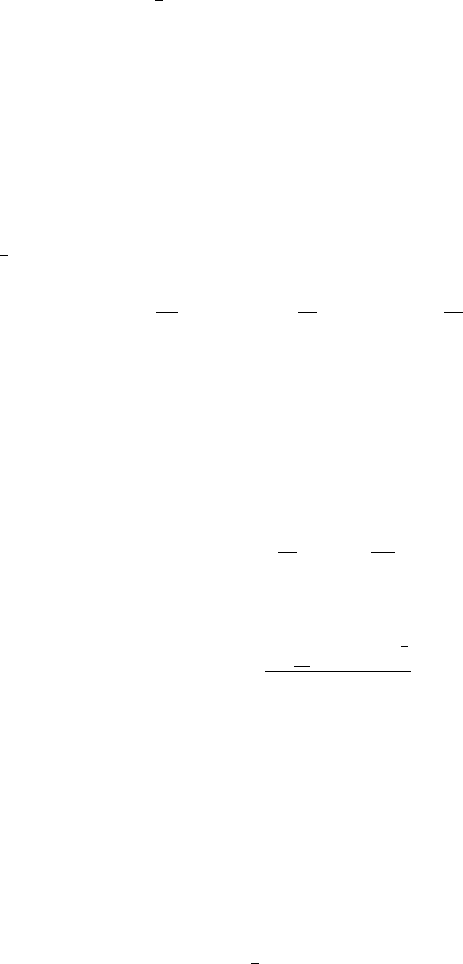Myint Tyn U., Debnath L. Linear Partial Differential Equations for Scientists and Engineers
Подождите немного. Документ загружается.


14.4 Explicit Finite Difference Methods 621
or,
u
i,j
=
1
4
(u
i+1,j
+ u
i−1,j
+ u
i,j+1
+ u
i,j−1
)+
1
4
h
2
f
i,j
where f
i,j
= f (i h, jh). This is known as the five-point formula.
Example 14.4.7. Find the numerical solution of the torsion problem in a
square beam governed by
∇
2
u = −2inD = {(x, y):0≤ x ≤ 1, 0 ≤ y ≤ 1}
with u (x, y)=0on∂D.
From the above five-point formula, we obtain
u
i,j
=
1
4
(u
i+1,j
+ u
i−1,j
+ u
i,j+1
+ u
i,j−1
) −
1
2
h
2
where h is the side-length of the unit square net.
We choose h =
1
2
,1/2
2
,1/2
3
,1/2
4
to calculate the corresponding nu-
merical values u
i,j
=0.1250, 0.1401, 0.1456, 0.1469.
Note that the known exact analytical solution is 0.1474.
Example 14.4.8. Using the explicit finite difference method, find the solu-
tion of the Dirichlet problem
u
xx
+ u
yy
=0, in 0 <x<1, 0 <y<1,
u (x , 0) = x , u (x, 1) = 0, on 0 ≤ x ≤ 1,
u (x , y)=0, for x =0,x=1 and 0≤ y ≤ 1.
We use four interior grid points (that is, i, j =1, 2, 3, 4) as shown in
Figure 14.4.2 in the (x, y)-plane.
We apply the explicit finite difference formula (14.4.32) to obtain four
algebraic equations
−4u
2,2
+ u
3,2
+ u
1,2
+ u
2,3
+ u
2,1
=0,
−4u
2,3
+ u
3,3
+ u
1,3
+ u
2,4
+ u
2,2
=0,
−4u
3,2
+ u
4,2
+ u
2,2
+ u
3,3
+ u
3,1
=0,
−4u
3,3
+ u
4,3
+ u
2,3
+ u
3,4
+ u
3,2
=0.
The given boundary conditions imply that u
2,1
= u
2,4
= u
3,1
= u
3,4
=
u
4,2
= u
4,3
=0,u
1,2
=
1
3
and u
1,3
=
2
3
so that the above system of equations
becomes
−4u
2,2
+ u
3,2
+
1
3
+ u
2,3
=0,
−4u
2,3
+ u
3,3
+
2
3
+ u
2,2
=0,
−4u
3,2
+ u
2,2
+ u
3,3
=0,
−4u
3,3
+ u
2,3
+ u
3,2
=0.

622 14 Numerical and Approximation Methods
Figure 14.4.2 The square grid system.
In matrix notation, this system reads as
⎡
⎢
⎢
⎢
⎢
⎢
⎢
⎢
⎢
⎣
−4110
1 −40 1
10−41
011−4
⎤
⎥
⎥
⎥
⎥
⎥
⎥
⎥
⎥
⎦
⎡
⎢
⎢
⎢
⎢
⎢
⎢
⎢
⎢
⎣
u
2,2
u
2,3
u
3,2
u
3,3
⎤
⎥
⎥
⎥
⎥
⎥
⎥
⎥
⎥
⎦
=
⎡
⎢
⎢
⎢
⎢
⎢
⎢
⎢
⎢
⎣
−
1
3
−
2
3
0
0
⎤
⎥
⎥
⎥
⎥
⎥
⎥
⎥
⎥
⎦
.
The solutions of this system are
u
2,2
=
11
72
,u
2,3
=
16
72
,u
3,2
=
4
72
,u
3,3
=
5
72
.
(D) Simultaneous First-Order Equations
We recall the wave equation (14.4.1) in 0 <x<1, t>0. Introducing two
auxiliary variables v and w by v = u
t
and w = c
2
u
x
, the wave equation
gives two simultaneous first-order equations
v
t
= w
x
,w
t
= c
2
v
x
. (14.4.38)

14.4 Explicit Finite Difference Methods 623
The initial values of v and w are given at t =0forallx in 0 <x<1.
The boundary condition on v and w is also prescribed on the lines x =0
and x =1fort>0.
The explicit finite difference method can be used to determine v and
w in the triangular domain of dependence bounded by the characteristics
x − ct = 0 and x + ct =1.
The finite difference approximations to the differential equations (14.4.38)
are
1
k
(v
i,j+1
− v
i,j
)=
1
2h
(w
i+1,j
− w
i−1,j
) , (14.4.39)
1
k
(w
i,j+1
− w
i,j
)=
c
2
2h
(v
i+1,j
− v
i−1,j
) , (14.4.40)
where th e forward difference for v
t
or w
t
and the central difference for v
x
or w
x
are used. However, the central difference approximations to (14.4.38)
can also be utilized to obtain
1
2k
(v
i,j+1
− v
i,j−1
)=
1
2h
(w
i+1,j
− w
i−1,j
) , (14.4.41)
1
2k
(w
i,j+1
− w
i,j−1
)=
c
2
2h
(v
i+1,j
− v
i−1,j
) . (14.4.42)
We examine the stability of the above two sets of finite difference formu-
las with c = 1. The von Neumann stability method is applied by replacing
i and j by r and s respectively. The error function e
r,s
given by (14.4.10)
is substituted in (14.4.39)–(14.4.40) to obtain the stability relations
A (p − 1) = εiB sin αh, (14.4. 43)
B (p − 1) = εiA sin αh, (14.4.44)
where the initial perturbations in v and w along t = 0 are A exp (iαrh)and
B exp (iαrh) respectively with two different constants A and B.
Elimination of A and B from the above relations gives
(p − 1)
2
+ ε
2
sin
2
αh =0
or
p =1+
iε sin αh,
and
|p| =
1+ε
2
sin
2
αh
1
2
∼ 1+
1
2
ε
2
sin
2
αh =1+O
ε
2
. (14.4.45)
Since |p| > 1+O (ε), the finite difference scheme for the finite time-step
t = sk would be unstable as the grid sizes tend to zero.
A similar stability analysis for (14.4.41)–(14.4.42) leads to the condition

624 14 Numerical and Approximation Methods
p −
1
p
2
+4ε
2
sin
2
αh =0. (14.4.46)
This scheme is stable for ε ≤ 1.
Another finite difference approximation to the coupl ed system (14.4.38)
is
1
2h
(v
r+1,s
− v
r−1,s
)=
1
k
w
r,s+1
−
1
2
(w
r+1,s
− w
r−1,s
)
, (14.4.47)
1
2h
(w
r+1,s
− w
r−1,s
)=
1
k
v
r,s+1
−
1
2
(v
r+1,s
− v
r−1,s
)
. (14.4.48)
A similar stability analysis can be carried out for these systems by
substituting v
r,s
= Ap
s
e
iαrh
and w
r,s
= Bp
s
e
iαrh
into the equations. Elim-
ination of A/B yields the stability equation
p =cosαh +
i
ε
sin αh,
or
|p|
2
=cos
2
αh +
1
ε
2
sin
2
αh ≤ 1. (14.4.49)
Hence, the scheme is stable provided that
ε ≥ 1, that is,k≤ h. (14.4.50)
14.5 Implicit Finite Difference Methods
From a computational point of view, the explicit finite difference algorithm
is simple and convenient. However, as shown in Section 14.4(B), the major
difficulty in the method for solving parabolic partial differential equations
is the severe restriction on the time-step imposed by the stability condi-
tion ε ≤
1
2
or k ≤ h
2
/2κ. This difficulty is also present in the explicit finite
difference method for the solution of hyperbolic equations. In order to over-
come the above difficulty, we d evelop implicit finite difference schemes for
solving partial differential equations.
(A) Parabolic Equations
One of the successful implicit finite difference schemes is the Crank and
Nicolson Method (1947), which is based on six grid points. This method
eliminates the major difficulty involved in the explicit scheme. When
the Crank–Nicolson implicit scheme is applied to the parabolic equation
(14.4.13), u
xx
is replaced by the mean value of the finite difference values

14.5 Implicit Finite Difference Methods 625
in the jth and the (j + 1) th row so that the finite difference approximation
(14.4.13) becomes
1
k
(u
i,j+1
− u
i,j
)=
κ
2h
2
[(u
i+1,j+1
− 2u
i,j+1
+ u
i−1,j+1
)
+(u
i+1,j
− 2u
i,j
+ u
i−1,j
)] , (14.5.1)
or
2(1+ε) u
i,j+1
− ε (u
i−1,j+1
+ u
i+1,j+1
)
=2(1− ε) u
i,j
+ ε (u
i−1,j
+ u
i+1,j
) , (14.5.2)
where ε =
kκ/h
2
is a parameter.
The left side of (14.5.2) is a linear combination of three unknowns in
the (j + 1) th row, and the right side involves three known values of u in
the jth row of the grid system in the (x, t)-plane. Equation (14.5.2) is
called the Crank–Nicolson implicit formul a. This formula (or its suitable
modification) is widely used for solving parabolic equations. If there are n
internal grid points along each jth row, then, for j = 0 and i =1,2,3,...,
n, the implicit formula (14.5.2) gives n simultaneous algebraic equations
for n unknown values of u along the first jth row (j = 0) in terms of given
boundary and initial data. Similarly, if j = 1 and i =1,2,3,..., n, equation
(14.5.2) represents n unknown values of u along the second jth row (j =1)
and so on. This means that the method involves the solution of a system of
simultaneous algebraic equations. In practice, the Crank–Nicolson scheme
is convergent and unconditionally stable for all finite values of ε, and has
the advantage of reducing the amount of numerical computation.
This implicit scheme can b e further generalized by introducing a numer-
ical weight factor λ in the modified version of the explicit equation (14.4.16)
which is written below by approximating u
xx
in (14.4.13) in the (j +1)th
row instead of the jth row.
1
k
(u
i,j+1
− u
i,j
)=
κ
h
2
(u
i+1,j+1
− 2u
i,j+1
+ u
i−1,j+1
) , (14.5.3)
or
u
i,j+1
− u
i,j
= ε (u
i+1,j+1
− 2u
i,j+1
+ u
i−1,j+1
) . (14.5.4)
Introducing the numerical factor λ, this can be replaced by a more
general difference equation in the form
u
i,j+1
− u
i,j
= ε
λδ
2
x
u
i,j+1
+(1− λ) δ
2
x
u
i,j
!
, (14.5.5)
where 0 ≤ λ ≤ 1andδ
2
x
is the difference operator defined by
δ
2
x
u
i,j
= u
i+1,j
− 2u
i,j
+ u
i−1,j
. (14.5.6)
Another equivalent form of (14.5.5) is

626 14 Numerical and Approximation Methods
(1 + 2ελ) u
i,j+1
− ελ (u
i+1,j+1
+ u
i−1,j+1
)
= {1 − 2ε (1 − λ)}u
i,j
+ ε (1 − λ)(u
i+1,j
− u
i−1,j
) . (14.5.7)
This is a fairly general implicit formula which reduces to (14.5.4) when
λ =1.Whenλ =
1
2
, (14.5.7) becomes the Crank–Nicolson formula (14.5.2).
Finally, if λ = 0, this implicit difference equation reduces to the explicit
equation (14.4.17).
The Richardson explicit scheme was found to be unconditionally unsta-
ble in Section 14.4. This undesirable feature of the scheme can be elimi-
nated by considering the corresponding implicit scheme. In terms of δ
2
x
,the
Richardson equation (14.4.22) can be expressed as
u
i,j+1
=2εδ
2
x
u
i,j
+ u
i,j−1
. (14.5.8)
To obtain the implicit Richardson formula, we replace δ
2
x
u
i,j
by
1
3
δ
2
x
(u
i,j+1
+ u
i,j
+ u
i,j−1
) in (14.5.8) and we obtain
1 −
2 ε
3
δ
2
x
u
i,j+1
=
2ε
3
δ
2
x
u
i,j
+
1+
2ε
3
u
i,j−1
. (14.5.9)
This implicit scheme can be shown to be unconditionally stable. To
prove this result, we apply the von Neumann stability method with the
error function (14.5.9) to obtain the equation for p as
(1 + a) p
2
+ ap +(a − 1) = 0, (14.5.10)
where
a ≡
8ε
3
sin
2
αh
2
. (14.5.11)
The roots of the quadratic equation are
p =
−a +
4 − 3a
2
1
2
2(1+a)
. (14.5.12)
This gives |p|≤1 for all values of a. Hence, the result is proved.
Example 14.5.1. Obtain the numerical solution of the following p arabolic
system by using th e Crank–Nicolson method
u
t
= u
xx
, 0 <x<1,t>0,
u (0,t)=u (1,t)=0,t≥ 0,
u (x , 0) = x (1 − x) , 0 ≤ x ≤ 1.
We recall the Crank–Nicolson equation (14.5.2) and then set h =0.2
and k =0.01 so that ε =
1
4
. The boundary and initial conditions give

14.5 Implicit Finite Difference Methods 627
u
0,0
= u
5,0
= u
0,1
= u
5,1
= 0 and u
i,0
= u (i h, 0) = ih (1 − ih), i =1,2,
3, 4. Consequently, formula (14.5.2) leads to the foll owing system of four
equations:
−u
0,1
− u
2,1
+10u
1,1
= u
0,0
+ u
2,0
+6u
1,0
−u
1,1
− u
3,1
+10u
2,1
= u
1,0
+ u
3,0
+6u
2,0
−u
2,1
− u
4,1
+10u
3,1
= u
2,0
+ u
4,0
+6u
3,0
−u
3,1
− u
5,1
+10u
4,1
= u
3,0
+ u
5,0
+6u
4,0
.
Using the boundary and initial conditions, the above system becomes
−u
2,1
+10u
1,1
=1.20
−u
1,1
+10u
2,1
− u
3,1
=1.84
−u
2,1
− u
4,1
+10u
3,1
=1.84
−u
3,1
+10u
4,1
=1.20.
These equations can be solved by direct elimination to obtain the solutions
as u
1,1
=0.1418, u
2,1
=0.2202, u
3,1
=0.2202, u
4,1
=0.1420.
(B) Hyperbolic Equations
We consider an implicit finite difference scheme to solve the initial boundary-
value problem consisting of the first-order hyperbolic equation
∂u
∂t
+ c
∂u
∂x
=0, (c>0) , (14.5.13)
with the initial data u (x, 0) = U (x) and the boundar y condition u (0,t)=
V (t)where0≤ x, t<∞.
The implicit finite difference approximation to (14.5.13) is
1
k
(u
i,j+1
− u
i,j
)+
c
h
(u
i,j+1
− u
i−1,j+1
)=0,
or
u
i,j
=(1+ε) u
i,j+1
− εu
i−1,j+1
, (14.5.14)
where ε =(ck/h).
The stability of the scheme can be examined by using the von Neumann
method with the error function (14.4.10). It turns out that
p =[1− ε + ε exp (−iαh)]
−1
, (14.5.15)
from which it follows that |p|≤1 for all h. Hence, the implicit scheme is
unconditionally stable.

628 14 Numerical and Approximation Methods
We next solve the wave equation u
tt
= c
2
u
xx
by an implicit finite differ-
ence scheme. In this case, u
tt
is replaced by the central difference formula,
and u
xx
by the mean value of the central difference values in the (j − 1) th
and (j + 1) th rows. Consequently, the implicit difference approximation to
the wave equation is
u
i,j+1
− 2 u
i,j
+ u
i,j−1
=
ε
2
2
[(u
i+1,j+1
− 2u
i,j+1
+ u
i−1,j+1
)
+(u
i+1,j−1
− 2 u
i,j−1
+ u
i−1,j−1
)] ,
(14.5.16)
where ε =(ck/h).
Expressing the solution for the (j +1)thstepintermsofthetwopre-
ceding steps gives
2
1+ε
2
u
i,j+1
− ε
2
(u
i−1,j+1
+ u
i+1,j+1
)
=4u
i,j
+ ε
2
(u
i−1,j−1
+ u
i+1,j−1
) − 2
1+ε
2
u
i,j−1
.
(14.5.17)
The N grid points along the time step, j =0,i =1,2,3,..., N,
(14.5.17) along with the finite difference approximation to the boundary
condition give N simultaneous equations for the N unknown values of u
along the first time step. This constitutes a tridiagonal system of equations
that can be solved by direct or iterative numerical methods.
To investigate the stability of the imp licit scheme, we apply the von
Neumann stability method with the error function (14.4.10). This leads to
the equation
p +
1
p
=2
1+2ε
2
sin
2
αh
2
−1
,
or
p
2
− 2bp +1=0, (14.5.18)
where b =
1+2ε
2
sin
2
αh/2
−1
so that 0 <b≤ 1.
Hence, the stability condition is
|p|≤1 (14.5.19)
which is always satisfied provided 0 <b≤ 1, that is, ε<1 for all positive
h. This confirms the unconditional stability of the scheme.
A more general implicit scheme can be introduced by replacing u
xx
in
the wave equation (14.4.1) with
u
xx
∼
1
h
2
λ
δ
2
x
u
i,j+1
+ δ
2
x
u
i,j−1
+(1+2λ) δ
2
x
u
i,j
!
, (14.5.20)

14.6 Variational Methods and the Euler–Lagrange Equations 629
where λ is a numerical weight (relaxation) f actor and the central difference
operator δ
2
x
is given by (14.5.6). This general scheme allows us to approxi-
mate the wave equation with c = 1 by the form
δ
2
t
u
i,j
= ε
2
λ
δ
2
x
u
i,j+1
+ δ
2
x
u
i,j−1
+(1− 2λ) δ
2
x
u
i,j
!
, (14.5.21)
where ε = k/h. This equation reduces to (14.5.16) when λ =
1
2
, and to the
explicit finite difference result when λ =0.
It follows from von Neumann stabi lity anal ysis that the implicit scheme
is unconditionally stable for λ ≥
1
4
. Von Neumann introduced another fairly
general finite difference algorithm for the wave equation (14.4.1) in the form
δ
2
t
u
i,j
= ε
2
δ
2
x
u
i,j
+
ω
h
2
δ
2
t
δ
2
x
u
i,j
. (14.5.22)
This equation with appropriate boundary conditions can be solved by
the tridiagonal method. Von Neumann discussed the question of stability
of this implicit scheme and proved that the scheme is conditionally stable
if ω ≤
1
4
and unconditionally stable if ω>
1
4
.
14.6 Variational Methods and the Euler–Lagrange
Equations
To describe the variational methods and Rayleigh–Ritz appr oximate method,
it is convenient to introd uce the concepts of the inner product (pre-Hilbert)
and Hilbert spaces. An inner product space X consisting of elements u, v,
w, ... over the complex number field C is a complex linear space with an
inner product u, v : X ×X → C such that
(i) u, v =
v, u, where the bar denotes the complex conjugate of v,u,
(ii) αu + βv,w = α u, w + β v, w for any scalars α, β ∈ C,
(iii) u, u≥0; equality holds if and only if u =0.
By (i) u, u =
u, u,andsou, u is real. We denote u, u
1
2
= u,which
is called the norm of u. Thus, the norm is induced by the inner product.
Thus, every inner product space is a normed linear space under the norm
u =
u, u.
Let X be an inner product space. A sequence {u
n
} where u
n
∈ X for
every n is called a Cauchy sequence in X if and only if for every given ε>0
(no matter how small) we can find an N (ε) such that
u
n
− u
m
<ε for all n, m > N (ε) .
The space X is called complete if every Cauchy sequence converges to
apointinX. A complete normed linear space is called a Banach Space.A
complete linear inner product space is called a Hilbert Space and is usually
denoted by H.

630 14 Numerical and Approximation Methods
Example 14.6.1. Let C
n
be the set of all n-tuples of complex numbers. Thus,
C
n
is an n-dimensional Hilbert space with the inner product
x, y =
n
k=1
x
k
y
k
.
Obviously, the set of all n-tuples of real numbers R
n
is an n-dimensional
Hilbert space.
Example 14.6.2. Let l
2
be the set of all sequences with entries from C such
that
2
∞
k=1
|x
k
|
2
< ∞. This forms a Hilbert space with the inner product
x, y =
∞
k=1
x
k
y
k
.
Example 14.6.3. Let L
2
([a, b]) be the set of all square integrable functions
in the Lebesgue sense in an interval [a, b]. L
2
([a, b]) is a Hilbert space with
the inner product
u, v =
b
a
u (x)
v (x) dx.
We next introduce the notion of an operator in a Hilbert space H.An
operator A is a mapping from H to H (that is, A : H → H). It assigns to
an element u in H a new element Au in H. An op erator A is called linear
if it satisfies the property
A (αu + βv)=αAu + βAv for every α, β ∈ C.
An operator is said to be bounded if there exists a constant k such that
Au≤k u for all u ∈ H.
We consider a b oun ded operator A on a Hilbert space H. For a fixed
element v in H, the inner product Au, v in H can be regarded as a number
I (u)whichvarieswithu.Thus,Au, v = I (u)isalinear functional on H.
If there exists an operator A
∗
on a Hilbert space (A
∗
: H → H)such
that
Au, v = u, A
∗
v for all u, v ∈ H,
then A
∗
is called the adjoint of A. In general, A = A
∗
.IfA = A
∗
,thatis,
Au, v = u, Av for all u, v in H,thenA is called self-adjoint.
It is important to note that any bounded operator T on a real Hilbert
space (T : H → H) of the form T = A
∗
A is self-adjoint. This follows from
the fact that
Tu,v = A
∗
Au, v = Au, Av = u, A
∗
Au = u, T v.
